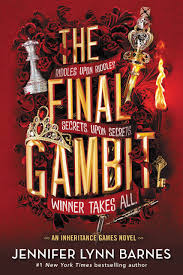
The Final Gambit (The Inheritance Games)
CHAPTER 72
by Barnes, Jennifer LynnThe chapter opens with the protagonist concluding an explanation, prompting Nash and Libby to depart ominously. As the group strategizes their next move, Xander reveals that Rebecca and Thea are at the cottage, dealing with family tensions after Eve uncovered a truth from Mallory. The protagonist then leads the boys to her room, where she presents blueprints of Hawthorne House, pinpointing the chapel as a key location. She explains that the hollow altar once concealed a USB and a cryptic message from Toby, hinting at his discovery of dark family secrets involving his adoption and the mysterious figure Liam.
The narrative delves into Toby’s past, revealing how he uncovered his adoptive father’s crimes, including the hidden remains of Liam. Toby left a series of hidden messages for his father before spiraling into self-destruction, culminating in the fire on Hawthorne Island. The protagonist reflects on Toby’s tragic legacy and his attempts to protect loved ones from the Hawthorne family’s poisonous secrets. This introspection underscores the emotional weight of their current mission: to locate the evidence Toby hid, possibly in the tunnels or another construction project from his time at Hawthorne House.
Jameson and the protagonist focus on the hedge maze as a potential hiding place, analyzing blueprints to narrow their search. The maze, a sprawling and intricate structure, symbolizes the complexity of the Hawthorne family’s secrets. As they prepare to search, Jameson subtly probes the protagonist about Grayson’s absence, hinting at unresolved tensions between them. The protagonist deflects, emphasizing Grayson’s emotional growth and his confrontation with Eve, which allowed him to move past his guilt over Emily.
In the maze’s center, Jameson presses the protagonist about her feelings for Grayson, forcing her to confront a truth she’s avoided. The chapter ends on a cliffhanger, with the protagonist refusing to answer Jameson’s unfinished question, leaving their dynamic—and the mystery of Toby’s hidden evidence—unresolved. The emotional and physical search for the truth mirrors the tangled paths of the maze, setting the stage for further revelations.
FAQs
1. What key discovery did the protagonist make about the chapel altar, and what does this reveal about Toby’s relationship with his father?
Answer:
The protagonist discovered that the chapel altar was hollow and functioned as a tomb, though it only contained a USB drive and a message from Toby (“I know what you did, Father”). This reveals that Toby had uncovered his father’s dark secret about Liam’s murder and left hidden messages as a form of communication and rebellion. The empty altar suggests Toby removed Liam’s remains, showing his rejection of his father’s legacy and the beginning of his self-destructive path (pages 294-295).2. How does the hedge maze connect to Toby’s hidden evidence, and what does the protagonist’s approach to searching it reveal about her problem-solving style?
Answer:
The hedge maze was one of several construction projects during Toby’s late teens, making it a potential hiding place for Liam’s remains. The protagonist analyzes blueprints chronologically and focuses on the maze as the most likely location, demonstrating her methodical approach. Her decision to start at the center and spiral outward shows strategic thinking, balancing efficiency with symbolic importance—the maze’s center represents the heart of the Hawthorne family’s secrets (pages 296-297).3. Analyze the significance of Jameson’s unfinished question about Grayson (“now that he’s so delightfully human…”). What underlying tension does this highlight?
Answer:
Jameson’s aborted question reflects his unresolved anxiety about the protagonist’s relationship with Grayson. His sharp, “wicked” tone masks vulnerability, as he fears Grayson’s emotional growth might rekindle their connection. The protagonist’s refusal to let him finish underscores the emotional complexity between the trio—Jameson’s insecurity, Grayson’s transformation, and her own guarded feelings. This moment crystallizes the love triangle’s tension while showing Jameson’s struggle to trust their bond (page 297).4. How does the chapter portray Toby’s motivations for protecting Eve, and what thematic connection does this create with the Hawthorne legacy?
Answer:
Toby sought to shield Eve from the Hawthorne fortune’s “poisonous tree”—the cycle of secrets (Liam’s murder) and trauma (his own adoption lie). Having failed to protect the protagonist’s mother, he projects that guilt onto Eve, fearing Blake would exploit her. This underscores the legacy’s central theme: wealth and power corrupt, forcing each generation to either perpetuate or break the cycle. Toby’s actions reflect both his brokenness and his attempt at redemption (pages 295-296).
Quotes
1. “The real Hawthorne legacy.”
This stark statement encapsulates the dark truth at the heart of the Hawthorne family history - the secrets, betrayals, and trauma that have shaped generations. It comes as the protagonist reflects on Toby’s tragic story and its consequences.
2. “I saw now why Toby was determined to stay away from Hawthorne House. I could understand why he’d wanted to protect my mother… and later… why he had needed to at least try to protect Eve from everything that came along with the Hawthorne fortune.”
This quote reveals the protagonist’s growing understanding of Toby’s motivations and the cyclical nature of the Hawthorne family’s destructive patterns. It shows how the past continues to influence present relationships.
3. “The evidence I stole is in the darkest hole…”
This cryptic phrase, repeated several times in the chapter, represents the central mystery the characters are trying to solve. It hints at the hidden location of crucial evidence about the family’s dark secrets while maintaining an air of ominous mystery.
4. “I knew what he was going to ask. I knew he wasn’t wrong to ask. But still, it stung. And the only way that he was ever going to stop asking… was if I gave him the full, unvarnished truth.”
This passage captures the emotional tension between characters and the theme of truth versus protection that runs through the story. It represents a turning point where the protagonist realizes she must confront difficult truths about relationships.
